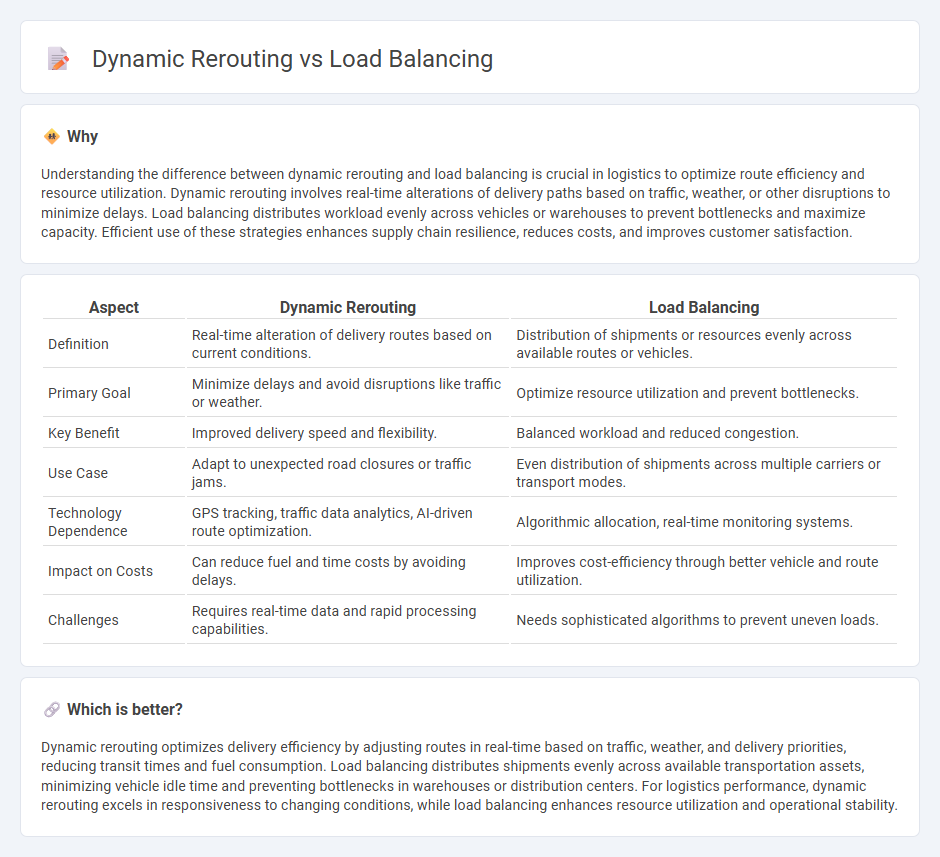
Dynamic rerouting in logistics involves continuously adjusting delivery routes based on real-time data such as traffic, weather, and shipment status to enhance efficiency and reduce delays. Load balancing focuses on evenly distributing cargo and workloads across available transportation resources to optimize capacity utilization and prevent bottlenecks. Explore the differences and benefits of dynamic rerouting versus load balancing to optimize your supply chain operations.
Why it is important
Understanding the difference between dynamic rerouting and load balancing is crucial in logistics to optimize route efficiency and resource utilization. Dynamic rerouting involves real-time alterations of delivery paths based on traffic, weather, or other disruptions to minimize delays. Load balancing distributes workload evenly across vehicles or warehouses to prevent bottlenecks and maximize capacity. Efficient use of these strategies enhances supply chain resilience, reduces costs, and improves customer satisfaction.
Comparison Table
| Aspect | Dynamic Rerouting | Load Balancing |
|---|---|---|
| Definition | Real-time alteration of delivery routes based on current conditions. | Distribution of shipments or resources evenly across available routes or vehicles. |
| Primary Goal | Minimize delays and avoid disruptions like traffic or weather. | Optimize resource utilization and prevent bottlenecks. |
| Key Benefit | Improved delivery speed and flexibility. | Balanced workload and reduced congestion. |
| Use Case | Adapt to unexpected road closures or traffic jams. | Even distribution of shipments across multiple carriers or transport modes. |
| Technology Dependence | GPS tracking, traffic data analytics, AI-driven route optimization. | Algorithmic allocation, real-time monitoring systems. |
| Impact on Costs | Can reduce fuel and time costs by avoiding delays. | Improves cost-efficiency through better vehicle and route utilization. |
| Challenges | Requires real-time data and rapid processing capabilities. | Needs sophisticated algorithms to prevent uneven loads. |
Which is better?
Dynamic rerouting optimizes delivery efficiency by adjusting routes in real-time based on traffic, weather, and delivery priorities, reducing transit times and fuel consumption. Load balancing distributes shipments evenly across available transportation assets, minimizing vehicle idle time and preventing bottlenecks in warehouses or distribution centers. For logistics performance, dynamic rerouting excels in responsiveness to changing conditions, while load balancing enhances resource utilization and operational stability.
Connection
Dynamic rerouting in logistics optimizes delivery paths by continuously analyzing real-time traffic, weather, and demand data, thereby reducing transit times and fuel consumption. Load balancing ensures that shipments and resources are distributed evenly across vehicles and routes to maximize capacity utilization and prevent bottlenecks. Together, these strategies enhance operational efficiency by synchronizing route adjustments with shipment allocation, improving service reliability and cost-effectiveness.
Key Terms
**Load Balancing:**
Load balancing distributes network traffic evenly across multiple servers or resources to enhance performance, ensure redundancy, and prevent overload on any single system. It optimally allocates computing resources by analyzing real-time demand, response times, and server capacities, improving overall system reliability and scalability. Explore how load balancing strategies can transform your infrastructure efficiency and uptime.
Resource Allocation
Load balancing optimizes resource allocation by distributing workloads evenly across servers or network paths to prevent bottlenecks and improve performance. Dynamic rerouting adjusts data traffic in real-time to avoid congestion or failures, reallocating network resources based on current conditions. Explore more about how these strategies enhance efficiency and reliability in network management.
Throughput Optimization
Load balancing allocates network traffic evenly across multiple paths or resources to maximize throughput and minimize bottlenecks, ensuring efficient utilization of available bandwidth. Dynamic rerouting adjusts data flow in real-time by redirecting traffic away from congested or failed links to maintain optimal throughput and reduce latency. Explore how combining load balancing and dynamic rerouting techniques enhances network performance and throughput optimization.
Source and External Links
Load balancing (computing) - Wikipedia - Load balancing is the process of distributing tasks across computing resources to optimize processing efficiency and avoid overloading some while others are idle; it involves static and dynamic algorithms to manage workloads.
What Is Load Balancing? | IBM - Load balancing distributes network traffic among multiple servers to optimize application availability and deliver a smooth end-user experience, using hardware or software load balancers to route requests effectively among servers.
What is load balancing? | How load balancers work - Cloudflare - Load balancing improves a service's performance and reliability by evenly distributing traffic among servers, using static or dynamic algorithms to decide how requests are allocated based on server conditions.
 dowidth.com
dowidth.com